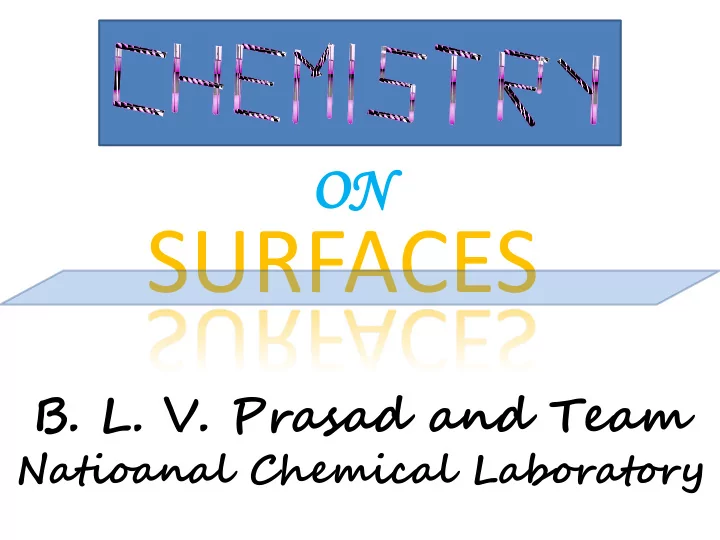

ON ON SURFACES B. L. V. Prasad and Team Natioanal Chemical Laboratory
What is Surface? IUPAC Definition: A boundary between two phases is called a surface or interface . The two words are often used synonymously, although interface is preferred for the boundary between two condensed phases and in cases where the two phases are named explicitly, e.g. the solid/gas interface. On the other hand if we are referring to only one phase we say surface e.g. the surface of a solid. http://old.iupac.org/reports/2001/colloid_2001/manual_of_s_and_t/node11.html
Why should we care about surfaces? https://www.visualnews.com/2011/09/02/the-statue-of-liberty-before-it-was-green/
Then how did the Statue of Liberty turn green? The Statue of Liberty gets its blue-green color from patina formed on its copper surface mainly through oxidation along with several other chemical reactions. The main constituent of patina contains a mixture of 3 compounds: Cu 4 SO 4 (OH) 6 in green; Cu 2 CO 3 (OH) 2 in green; and Cu 3 (CO 3 ) 2 (OH) 2 in blue. The following reactions are involved. 2Cu + O 2 → Cu 2 O 2Cu 2 O + O 2 → 4CuO Cu + S → 4CuS 2CuO + CO 2 + H 2 O → Cu 2 CO 3 (OH) 2 3CuO + 2CO 2 + H 2 O → Cu 3 (CO 3 ) 2 (OH) 2 4CuO + SO 3 +3H 2 O → Cu 4 SO 4 (OH) 6
What would have happened if Statue of Liberty was made of iron? To Do 1. What other metals/materials are protected by native oxide from further corrosion/rusting? 2. What other metals/amaterials are not protected by native oxide from corrosion/rusting? http://www.mstworkbooks.co.za/natural-sciences/gr9/gr9-mm-03.html
What way we can protect these metals from further damage? https://www.youtube.com/watch?v=EqMJMifNTIs 3Ni 0 +2Au 3+ 3Ni 2+ + 2Au 0 To Do 1. Read more about Delhi iron pillar. Why it doesn’t get rusted? 2. What is electroplating? Can you do it at home??
Okay surfaces are different, but why? The surface atoms that have less number of nearest neighbours feel unsatisfied. So crystal planes having such becomes more reactive. We use such reactive metal species as catalysts. 111 plane 100 plane
Catalyst: a substance that increases the rate of a chemical reaction without itself undergoing any permanent chemical change. https://www.youtube.com/watch?v=WSwayTjtVHk
Let’s do one catalysis experiment https://www.youtube.com/watch?v=UTfMrx7275w
https://www.youtube.com/watch?v=o1 _D4FscMnU https://www.youtube.com/wa tch?v=uMkzxV_y7tY What was the most important discovery of last century? 1. Internet 2. Mobile phone 3. E = mc 2 4. None of the above
How to improve the catalyst’s efficiency?
Why smaller particles behave better? n T S %S 0 1 1 100 1 13 12 92.3 10 11 2 55 42 76.3 3 2 5 1 T n n n 3 147 92 62.5 3 3 4 309 162 52.4 0 n 5 561 252 44.9 6 923 362 39.2 7 1415 492 34.7 2 8 2057 642 31.2 S 10 n 2 9 2869 812 28.3 10 3871 1002 25.8 n 1 11 5083 1212 23.8 12 6525 1442 22.0 13 8217 1692 20.5 14 10179 1962 19.2 15 12431 2252 18.1 16 14993 2562 17.0 17 17885 2892 16.1 18 21127 3242 15.3 19 24739 3612 14.6 20 28741 4002 13.9 N = shell number T = total number of atoms 100 3.3837E6 100002 2.9554 S = atoms on surface
100 100 80 80 60 S(%) 60 S(%) 40 40 20 20 0 0 0 2 4 6 8 10 12 14 16 18 20 0 20 40 60 80 100 n n
Other applications of surface interactions https://www.youtube.com/watch?v=0m8bWKHmRMM&t=5s https://www.youtube.com/watch?v=3nbjhpcZ9_g
Any other? Metal ions (in water) Reduction Aqueous ( citrate, bio synthesis etc. ) Turkevich et al J. Discuss. Faraday Soc. 1951, 11, 55.
Aqueous nanoparticle dispersion in water are not very stable 16 Before salt addition after salt addition B. L. V. Prasad et al. Chem. Soc. Rev. 2008, 37, 1871
“Naked to protected” state
“Dress” consciousness
“Dress” consciousness
(A) =Exposed functional group (-SO - 3 , + NH 3 , -COOH etc.) which directs dispersion stability in aqueous media =Head functional group (-SH,NH 2 etc.) which is attached to metal surface. (B)
Chemical Synthesis of Metal Nanoparticles H 2 O H 2 O Surfactant Reduction H 2 O H 2 O H 2 O Addition of capping H 2 O H 2 O agent Metal ions Monolayer protected (in water) Metal nanoparticles Reverse micelle Organic (Brust-Schriffrin method, reverse micelle process etc.) Brust et. al. 1994, Chem. Commun. 801.
“Appropriate” dresses Mountaineer Soldier Bridegroom
Nanomaterial synthesis/modifications – role of molecular tools Interfaces with the solvent/media Provides adaptability Prevents aggregation Provides stability Controls size, shape etc. Prevents degradation
Synthesis of nanoparticles in organic media and their transfer to aqueous media M. Brust, M. Walker, D. Bethell, D. J. Schiffrin and R. Whyman, Chemm. Commun. 1994, 801 Mercaptoundecanoic acid Organic dispersion 4-dimethylaminopyridine Aqueous dispersion Cetyltrimehylammonium bromide J. Simard, C. Briggs, A. K. Boal, V. M. Rotello, Chem. Commun. 2000, 1943 D. I. Gittins and F. caruso,. Angew. Chem. Int. Ed. 2001, 40, 3001 A. Swami, A. Kumar and M. Sastry, Langmuir, 2003, 19, 1168.
“Functional” Dresses
Targeted therapy https://www.youtube.com/watch?v=emEua2eJp1U
= fluorescent label = antibody or other targeting molecule (eg. folic acid) = molecules that assist preferential uptake (nutrients/BSA like protiens)etc. = drugs Highly specific targeting Preferential uptake Fluorescent labelling Functionalized nanoparticles (aqueous dispersoins) Better stability Higher retention Bio-compatibility Adapted from PhD thesis, Virginnia D’Britto
Chimreic nanoparticles Chimera The Chimera, according to Greek mythology, is a monstrous fire-breathing hybrid creature Mahakali Chimera
Thank you Synthesis Assembly and Applications of Materials (SAAM) Group Dr. Guruswamy Kumaraswamy Dr. Arunarka Valli Turaga
Recommend
More recommend